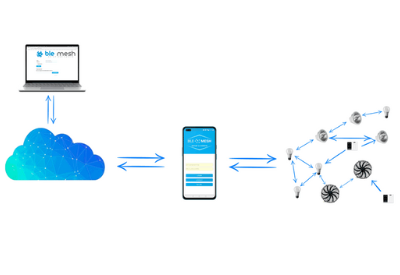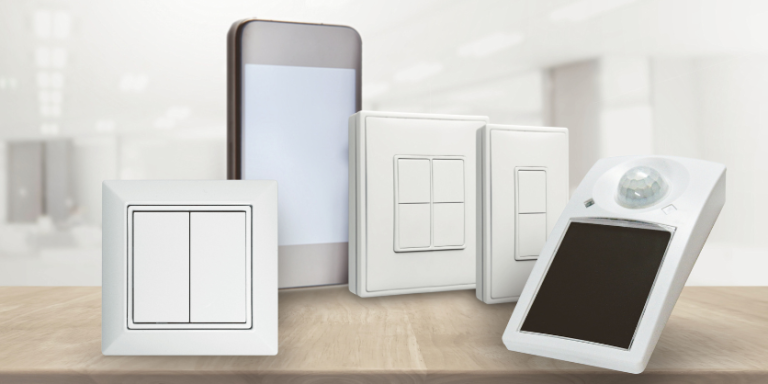Is a Bluetooth Mesh System for You? Practical Aspects to Consider in Vendor Compatibility, Installation & Usage

 Part 2 of our Bluetooth Mesh knowledge series –written for USLT exclusively by Alex Heiphetz, Ph.D., CEO of AHG, Inc. – dives deeper into the Bluetooth Mesh protocol.
Part 2 of our Bluetooth Mesh knowledge series –written for USLT exclusively by Alex Heiphetz, Ph.D., CEO of AHG, Inc. – dives deeper into the Bluetooth Mesh protocol.
By Alex Heiphetz, Ph.D.
For the uninitiated, you need three components to manufacture, install, commission, and control the Bluetooth Mesh smart lighting systems: hardware, firmware, and a software/mobile app.
Hardware: Bluetooth Mesh System on Chip (SoC) or module
A System on Chip (SoC) is an integrated electronic circuit (also known as a “chip”) that integrates all – or most – components of a computer or other electronic system. Major semiconductor companies (Nordic, Infineon, Qualcomm, Silicon Labs) produce Bluetooth Mesh SoC. They also provide Bluetooth Mesh Software Development Kit (SDK), sample firmware code for various applications, sample commissioning mobile applications for Android and IOS, and development kits. This makes it easier for the software developers to design applications that will work with their SoC.
Nordic leads the way in this area, with their nRF52833 and nRF52840 SoC being the most popular for Bluetooth Mesh lighting applications. nRF52840 is a multiprotocol unit supporting Zigbee and Thread should you need this option.
Which hardware will work better for you? The paper referenced here has a good discussion on the hardware selection considerations
Firmware
Bluetooth SIG has developed specifications for the Bluetooth Mesh standard (also called foundation) models. There are 50+ models that define the behavior of the Bluetooth Mesh network devices. There is a configuration model that defines the communication rules for the Bluetooth Mesh network configuration and grouping. Some generic models can be used for all types of electronic devices, such as on/off, power level, battery, etc. Finally, there are specific lighting models for the luminaries, switches, and sensors. These models can be used to set various lighting parameters and define lighting fixtures’ behavior in response to a sensor or switch events. There are also scenes and scheduling models.
Standard Bluetooth Mesh models provide a good selection for defining the behavior of a sophisticated smart lighting system. If standard models alone do not satisfy all of your requirements, a software developer can extend them to fit your exact needs.
Most semiconductor companies provide firmware code for the main foundation models as part of their Bluetooth Mesh SDK. The good thing about the standard models is just that — they are standard. This means that as long as the lighting system components adhere to the mesh standards, you can mix and match components from the different vendors. For example, you can use luminaries from one vendor, switches and sensors from another vendor, plus software and mobile apps from a third vendor and the system will work perfectly well.
Software/Mobile Apps
Both installers and customers need software and/or a mobile app so that they could add newly installed lighting accessories to the Bluetooth Mesh network (this is called “provision”) and configure and control network devices. For smart homes or small businesses, who often install the lighting systems themselves, a stand-alone mobile app not linked to a back-end cloud software will suffice. For the commercial large Bluetooth Mesh networks, you will usually need a mobile app/cloud software combo, with a back-end database holding network data. A word of warning: stand-alone mobile apps have several important deficiencies which may be important in your situation:
- You do not have user access control. Anyone who gets access to the mobile phone used for the network provisioning will be able to perform the changes.
- Unless you plan for the company/household to always use the same mobile device for controlling a Bluetooth Mesh network – and since you do not have a central repository of credentials – you will need to find a way to transfer network credentials between the smartphones.
- You will need to come up with the network data backup mechanism. Otherwise, if something happens with the smartphone used for the network provisioning, you won’t be able to control the network.

For commercial customers and/or customers who need to control multiple Bluetooth Mesh networks, you can create/buy/lease a cloud or local network software. This setup allows authorized users to review, commission, and control multiple Bluetooth Mesh networks remotely from any computer connected to the internet. Cloud or local network software is much more secure and robust than stand-alone mobile apps. However, in many instances, an option to control Bluetooth Mesh devices remotely is not enough. An installer or a customer needs to be on site, observe the effect of the lighting parameters settings or device groupings that he applies, and make immediate on-site adjustments if necessary.
From the usability and security perspective, a cloud software/mobile app combo seems to be the best arrangement. Bluetooth Mesh Commissioning software (developed by the author’s company – AHG, Inc.) uses this approach. It allows administrators and engineers to manage multiple Bluetooth Mesh networks, manage system users and their access privileges, and network device types. Generic network configuration is performed on a computer using a web dashboard. Installers and end-users use a mobile app on a smartphone to provision newly installed devices to the Bluetooth Mesh network and apply preset network configuration. If granted required privileges, they can also make adjustments to the preset network configuration. Customers and building managers can then perform additional adjustments to fit their needs using a mobile app and create scenes and schedules. This type of network does not need gateways: smartphones serve as gateways transferring data between the Bluetooth Mesh networks and the cloud.
You can find more details on the Bluetooth Mesh Commissioning software and a demo video here
Bluetooth Mesh Products + Vendor Compatibility
All Bluetooth Mesh-certified lighting accessories are compatible with each other. You can mix and match lighting fixtures, sensors, and switches from different vendors into one system, and possibly add HVAC and/or security systems to the same Bluetooth Mesh network.
You may also be able to integrate various non-Bluetooth Mesh lighting accessories into the same network. Multiple vendors at the 2022 LightFair, held last month in Las Vegas, demonstrated Bluetooth Mesh products that could be plugged into the wired lighting system and make it a part of a Bluetooth Mesh. You could now control them using the smartphone mobile app.
In May 2020, Bluetooth SIG started working with the Digital Illumination Interface Alliance (DIIA) on developing a standard interface that would allow luminaries that support DALI protocol (Digital Addressable Lighting Interface, a protocol for digital lighting control) to become a part of a Bluetooth Mesh network. Now the Bluetooth Mesh to DALI gateway specifications are completed and are used by the manufacturers to create products that make DALI-based lighting systems compatible with the Bluetooth Mesh hardware and software.
More details on the Bluetooth Mesh to DALI gateway are available here
The Bluetooth Mesh Smart Lighting Ecosystem
Smart lighting wireless systems provide significant benefits for all members of the lighting ecosystem: manufacturers, distributors, installers, and customers.
End users, such as commercial building managers and tenants, like the flexibility of the smart lighting systems, ease of control, ability to control lights remotely, and energy savings. Lighting system installers benefit from less labor and wiring involved in the smart lighting system installation. And distributors can offer their customers modern lighting products at a significantly lower cost than traditional wired lighting. Taking into account this trend, lighting manufacturers are adapting to the growing requests for wireless smart lighting systems — either by introducing new wireless lighting control products or by partnering with wireless lighting control manufacturers.
End users do not particularly care which wireless communication protocol their smart lighting system is using, but they do want the ability to control their lighting network with devices they already have, such as smartphones and tablets. Bluetooth Mesh allows manufacturers to accommodate this need with minimal investment.
What’s Involved in Switching to Bluetooth Mesh?
Manufacturers who want to transition into wireless lighting can either start manufacturing wireless lighting controls or integrate somebody else’s wireless lighting controls into their products. Creating wireless lighting controls of your own requires more time and money investment initially, but might be more profitable in the long run.
If you do want to start manufacturing your own wireless lighting controls, you will need to take care of at least two components: hardware and firmware. The earlier section of this article provides a brief overview of what is involved in the hardware selection and developing firmware for the Bluetooth Mesh products.
Traditionally, manufacturers also provide a software platform — either cloud software, a mobile app, or a combination of both. The software is used by the lighting system installers and customers to configure and control the system. This is not necessary though; as the number of standardized Bluetooth Mesh software products grows, you can form a partnership with several Bluetooth Mesh software providers and let your clients choose which system they want to use.
Distributors of Bluetooth Mesh lighting products have the flexibility to mix and match products from different manufacturers to fit the needs of each client. By including Bluetooth Mesh lighting systems in their product line, they will be offering the modern lighting products that customers want and that is easier and less expensive to install than the wired lighting systems.
Since Bluetooth Mesh is a standard, technically software provided by any of the manufacturers should work with devices from other manufacturers. Therefore, you should be able to pick the software package that you like the best and use it with the Bluetooth Mesh devices of all vendors. For large distributors, it may make sense to design their own or white-label a software package. There are several standardized software packages and IoT platforms that can be utilized as-is or with custom modifications.
Installers will find the installation of any wireless lighting system is faster and easier than a wired system for the simple reason that you need to do significantly less wiring. In a typical wireless lighting system, only lighting fixtures are connected to the power. Sensors and switches typically operate on the batteries and can be easily installed and relocated as needed. Installation of the wireless lighting systems is easier to plan and requires much less manpower and materials from the installers.
Instead of connecting light fixtures to controls using wires, installers are using software and/or a mobile app on a smartphone to add wireless controls to the network, group them, and define group interactions. This requires less qualification from the field workers than wiring. There is a learning curve in learning a new software system, but to be fair, these software systems have a similar look and functionality, have an intuitive interface, and are generally easy to use. All in all, transitioning to the wireless lighting systems for the installers means fewer materials, planning and labor, and fewer qualification requirements for the field employees.
End users of lighting systems benefit from the wireless smart lighting systems the most. They appreciate the flexibility and scalability of the wireless lighting, lower installation and maintenance costs, energy savings, and the data they can obtain to optimize building operations.
Building occupation and utilization often change over time. With wireless lighting systems, these changes are easy to accommodate. Building managers can easily add or remove lighting controls where needed without calling an electrician and disrupting building operations. They can change the grouping of the lighting fixtures, reconfigure which sensors or switches control which group of lights, change automatic schedules and saved lighting scenes as needed, and control dimming timing in response to the events received from a sensor or a switch.
Not surprisingly, the users are driving the trend for wireless lighting adoption.
Bluetooth Mesh Commissioning Software Considerations
As mentioned previously, software for the Bluetooth Mesh lighting networks configuration and control works with all Bluetooth Mesh-certified devices, regardless of the manufacturer. However, there is an important consideration for the software selection: end users of the lighting systems should use the same software package the installers used. The reason is simple: Bluetooth Mesh network credentials that prevent unauthorized access to the network are created by the mobile app or a cloud software when the Bluetooth Mesh network is formed and are known only to the software that was used for the initial BLE Mesh network commissioning.
Therefore, to provide a seamless experience for the installers and customers, you should consider the following:
- End users should have access to the same software package that installers were using during the initial lighting system commissioning
- If different software systems must be used by the installers and end users, both software packages must have import/export functionality to share the network credentials between the software platforms
- The software should have a user-access system that may grant different privileges to installers, building managers, and tenants
- A mobile app or a cloud software used for the on-site device commissioning and control should be linked to the back-end central database for storing network credentials and current configuration
- There should be a mechanism in place to prevent network data corruption due to simultaneous access by different users
- All communication between the mobile app/a user computer and a central database should be secure
To read Part 1 in this series, Is Bluetooth Mesh the Best Choice for Smart Lighting? click here









